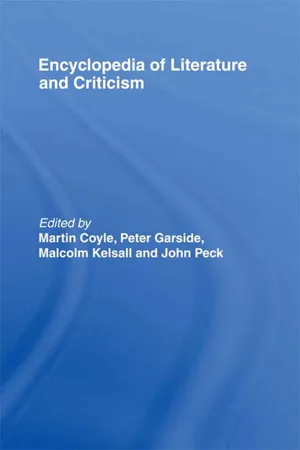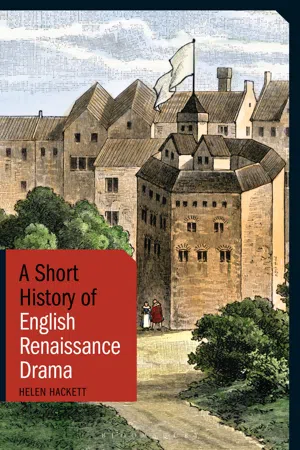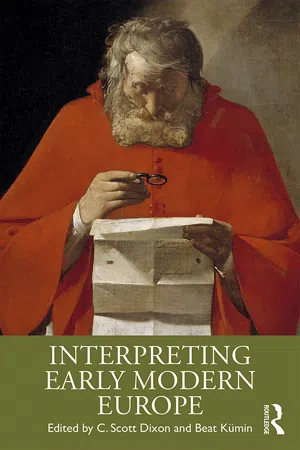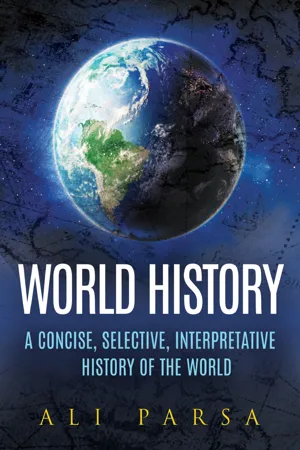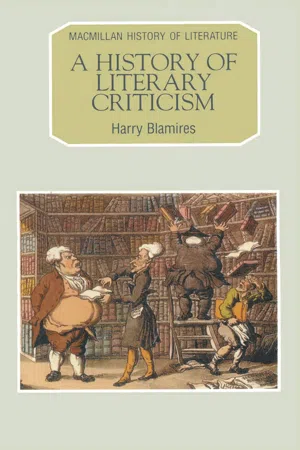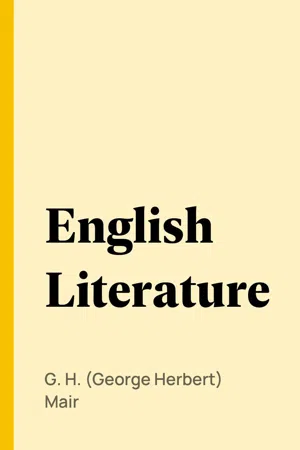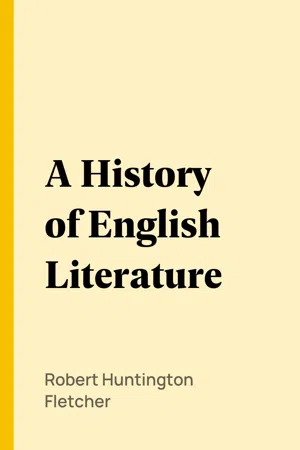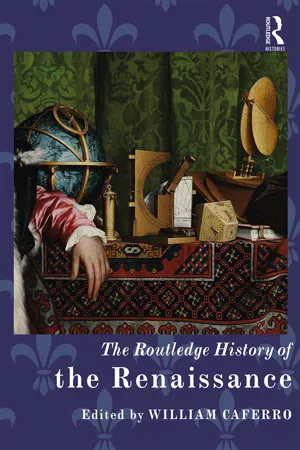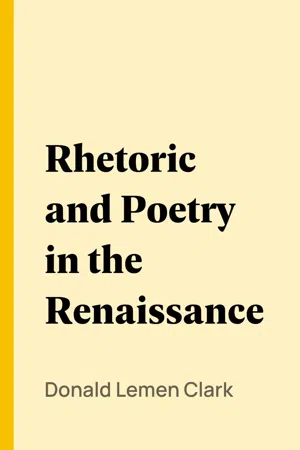Literature
Renaissance
The Renaissance was a cultural movement in Europe during the 14th to 17th centuries, characterized by a revival of interest in classical learning, art, and literature. It marked a shift from the medieval to the modern world, with a focus on humanism, individualism, and the exploration of new ideas. Renaissance literature often reflected these themes through works that celebrated human potential and the beauty of the natural world.
Written by Perlego with AI-assistance
Related key terms
12 Key excerpts on "Renaissance"
- eBook - ePub
- Martin Coyle, Peter Garside, Malcolm Kelsall, John Peck(Authors)
- 2002(Publication Date)
- Routledge(Publisher)
4 The Renaissance George Parfitt DOI: 10.4324/9780203403624-6This essay is being written in the twentieth century, at a time when (at least in some academies) long-held views about the nature of literature and literary criticism are being overhauled or displaced. In considering what the term ‘the Renaissance’ means, I am aware that prevailing definitions have their origins in times before my own, and that I am inevitably influenced both by these definitions and by a process of redefinition which is continuing as I write.Collins English Dictionary (1979) defines ‘Renaissance’ simply as ‘revival’ or ‘rebirth’, but it describes ‘the Renaissance’ in epochal language as ‘the period of European history marking the waning of the Middle Ages and the rise of the modern world; usually considered as beginning in Italy in the 14th century’. If this period definition is applied only to England, it needs to be added that the English Renaissance is usually understood to begin no sooner than the start of the sixteenth century. If we link ‘the Renaissance’, as description of a period, with ‘Renaissance’, defined as ‘rebirth/revival’, however, we clearly have an evaluative description. This much is perhaps intimated even in Collins's phrase about ‘the waning of the Middle Ages’, which certainly suggests that medievalism in the period is something enervated and in process of being replaced by a new dynamic: Death is giving way to (new) Birth. So far as England is concerned, there is also perhaps the sense that until ‘the Renaissance’ reached these shores from Italy this was a barbaric province in Europe's cultural empire.So it is misleading to consider ‘the Renaissance’ as merely a period term. To use it in a purportedly neutral way (in the sense, say, of ‘the reign of Victoria’) is to suppress recognition of the term's value-laden basis. How judgemental ‘the Renaissance’ is becomes clearer when we notice that the basic meaning ‘rebirth’ requires the question ‘rebirth of what?’; to which the stock answer for the historical period is ‘classicism’. That which is born again must have been dead, and in so far as we think of rebirths as good events, we must presumably consider deaths as bad. So the Middle Ages are to be seen as a period which lacked the good which is classicism. Moreover, if we develop the valuation involved in the idea of ‘the Renaissance’ as classicism reborn and go on to seek out this valuation in sixteenth-century England, we shall find ourselves noticing and valuing some phenomena (say, Surrey's translation of Virgil into blank verse) while deprecating or ignoring others (perhaps the last gasps of the native alliterative tradition). The organic nature of the image of birth/death/rebirth will also encourage us to think cyclically, tracing development and decline in a way which unites period and evaluation: as the Middle Ages wane and the modern world rises, we move into a period of vitality and juvenescence. - eBook - ePub
- Helen Hackett(Author)
- 2012(Publication Date)
- I.B. Tauris(Publisher)
c. 1585–1603) and the Jacobean period (1603–25) since these produced most of the Renaissance plays that are well known today. Its aims are threefold: to convey the variety and richness of English Renaissance drama; to explore why and how this period produced this creative explosion; and to suggest why these plays continue to have such hold upon readers and audiences in the modern world.WHAT WAS THE Renaissance?At the outset it is worth pausing to consider what we mean by the term ‘Renaissance’. Literally it means ‘rebirth’, and the Oxford English Dictionary defines it as ‘the revival of the arts and high culture under the influence of classical models, which began in Italy in the fourteenth century and spread throughout most of Europe by the end of the sixteenth.’6 It took a little time for these developments to reach England, and therefore the English Renaissance is usually regarded as having taken place in the sixteenth and seventeenth centuries. In English drama, the period of greatest activity and artistic achievement was from the late 1580s to the 1620s, covering the last part of the Elizabethan period (Elizabeth I reigned from 1558 to 1603) and the Jacobean period (the reign of James I, 1603–25).Fifteenth-century Italy saw an artistic and intellectual flowering which many of its participants regarded self-consciously as a movement of renewal and of the rediscovery of the classical arts and scholarship that had fallen into decay in the middle ages. Classicism became associated with purity, naturalism, and clarity, as opposed to the supposed gothic barbarity of intervening centuries. This attitude was crystallized in the term rinascita , or rebirth, first used by the Italian artist and critic Giorgio Vasari (1511–74) in his book The Lives of the Artists (1550) to describe how Italian painters and sculptors of the fourteenth to sixteenth centuries had revived classical style and techniques. The general use of the term ‘Renaissance’ in cultural history began later, with The Civilization of the Renaissance in Italy (1860) by the Swiss author Jacob Burckhardt (1818–97). For Burckhardt the cultural advances of Italy in the fourteenth to sixteenth centuries were dependent upon the existence of competing independent city states ruled by despotic dynasties, who deployed artistic patronage as a means of celebrating and promoting their power. In this culture, despots and artists alike personified the triumph of the self-interested human will: ‘Despotism . . . fostered in the highest degree the individuality not only of the tyrant or condottiere himself, but also the men whom he protected or used as his tools.’ Burckhardt takes as an example Leon Battista Alberti (1404–72), an author, artist, and architect: ‘an iron will pervaded and sustained his whole personality; like all the great men of the Renaissance, he said, “Men can do all things if they will.”’ In his mastery of a wide and diverse range of intellectual interests Alberti also exemplified Burckhardt’s idea of the Renaissance man, ‘the “all-sided man” – l’uomo universale ’.7 - eBook - ePub
- C. Scott Dixon, Beat Kümin, C. Scott Dixon, Beat Kümin(Authors)
- 2019(Publication Date)
- Routledge(Publisher)
4 Renaissance Edward Muir The interpretive challenge for Renaissance studies began in the nineteenth century, not the fourteenth, fifteenth, and sixteenth, the age of the Renaissance. Unlike the Enlightenment, no one living during the Renaissance knew about it. An ardent anti-clerical republican, Jules Michelet (1798–1874), popularised the term Renaissance (rebirth), and hence the French word still prevails in the English-speaking world in place of the Italian Rinascimento. A whiff of Michelet’s secular prejudices still lingers over the idea of the Renaissance. During the same period the Swiss Protestant, Jacob Burckhardt (1818–1897) wrote The Civilization of the Renaissance in Italy, which introduced art and cultural history as a pre-eminent means for understanding the period. Burckhardt’s innovative approach of Kulturgeschichte has been especially attractive because of his evocative portrait of how political illegitimacy produced artistic and intellectual vitality, epitomised by his famous phrase, ‘the state as a work of art’ (1958, 21). The Prussian Georg Voigt (1827–1891) added to the interpretive mix the term ‘humanism’, designating a movement that began with Francesco Petrarca [Petrarch] (1304–1374), who popularised among intellectuals methods of critical philology rooted in classical Antiquity. From this influential trio, none Italian, came a remarkably tenacious paradigm that defined the Renaissance as a period that began in the fourteenth century in Italy in reaction to the alleged clerical domination of the Middle Ages and that was characterised by secularism, artistic and cultural creativity, and humanism (defined as the critical, historical methods of philology) - eBook - ePub
World History
A Concise, Selective, Interpretive History of the World
- Ali Parsa(Author)
- 2017(Publication Date)
- Sentia Publishing(Publisher)
Now, let us get started with the discussion of the European Renaissance. At the outset, I must clarify one of the most common misunderstandings of what Renaissance means. Most people associate the term Renaissance mainly with fantastic art, paintings, and architecture produced by great masters, such as Michelangelo, Rafael, and da Vinci. But in reality, the Renaissance was a much broader intellectual-humanistic transformation that changed the whole worldview of Western Europeans and subsequently the whole world. Art and architecture, as beautiful and publicly enjoyed and appreciated as they are, are only the products of a much bigger change.Renaissance means rebirth. Something must die in order to be born again. That one thing, according to the people who invented the term in the fifteenth century, was the glorious classic era of the Greco-Roman times, before the fall of Rome in the fifth century, when human beings were valued and creativity was rewarded. Out of the ashes of the Late Middle Ages, which were dominated by dogmatism and otherworldliness, a new focus on human beings began.The Renaissance HumanismA good way of understanding the essence of the Renaissance is to break it down into its three major aspects. The first aspect of the Renaissance, as it is most easily understood, is the yearning for the classics. It is not surprising that the Italians, who considered themselves to be descendants of and successors to the great Roman civilization, would be the pioneers of this movement. The father of Renaissance humanism is Francesco Petrarch. Although Italians had become wealthy through international maritime trade, they were politically divided. Feudalism, as had been developed in the rest of Europe, was not as strong in Italy. Instead, an urban economy with a growing middle class was taking shape. Petrarch, who was an erudite man, well versed in classical Latin and possessing a great knowledge of history, should be credited as the first person who tried to awaken the Italians to their glorious past in which human beings were valued and individuals were respected. - eBook - ePub
- Harry Blamires(Author)
- 1991(Publication Date)
- Bloomsbury Academic(Publisher)
3 The RenaissanceThe term ‘Renaissance’ is sometimes so vaguely used that it tends to represent a period of history rather than a historical development. In its strictest sense, at least for the literary world, the ‘Renaissance’ is the rediscovery of the ancient classics of Greece and Rome which scholars edited, translated, and wrote commentaries on. With the capture of Constantinople by the Turks in 1453 the drift of Greek scholars to Italy was accelerated. Increasingly manuscripts were transferred from Byzantium to the west and copied. It must be recalled that the Emperor Constantine (288–337) had transferred his capital to Byzantium in 328 and renamed the city ‘Constantinople’. After the death of the emperor Theodosius the Great (c.346–395) the Roman Empire was split into two halves, one of Theodosius’s sons ruling from Rome, the other from Constantinople. As Rome declined and ceased finally in 476 to be the seat of an emperor, Constantinople remained for nearly a thousand years an imperial centre capable of defending its culture against invaders.The increasing influx of scholarship from Byzantium into western Europe came at a time when new impulses were already at work and, it may be argued, merely quickened and intensified an already inevitable reaction against the theological, philosophical, and artistic culture of the Middle Ages. The revival of Greek and Latin forms, first in Italy, and then elsewhere in west Europe, was not just a literary development, but affected architecture too. Economically Italy was especially ripe for change in that the fabric of feudalism had been weakened by the growing wealth and importance of trading cities such as Florence and Venice, and the growing power of the now urbanised middle class. This was, of course, to be the pattern of change in other European countries too. Currents of new vitality gave an impulse to cultural productivity and development just when a source of fresh inspiration was being tapped in the rediscovery of the classics. - John Monfasani(Author)
- 2016(Publication Date)
- Routledge(Publisher)
38 .I find irrefutable the medievalists’ claims for the Renaissance of the twelfth century. The twelfth-century poets, grammarians, commentators, translators, and other scholars were responsible for an enormously successful recovery of antique language, learning, and literature39 . That recovery took place mainly in northern Europe and continued into the thirteenth century. Nonetheless by the fourteenth century Italians had clearly taken the lead and would eventually produce far more brilliant results than did the earlier medieval humanists.But what is critical to understand is that at this very same time in the thirteenth and especially fourteenth centuries Italians were also absorbing northern scholasticism and developing their own very distinctive university structure. As Kristeller has pointed out, even if one denies that there was a Renaissance, one cannot deny that there was a Renaissance of Italy40 . From a relatively backward cultural position before the fourteenth century, Italy surged to leadership by the late fifteenth century as cultural forms that it had been developing since at least the thirteenth century began to exert decisive influence on the rest of Europe. Indeed, I would go further and contend that the Renaissance was a period of Italian cultural leadership in Europe displacing traditional French cultural leadership41 , and that the end of the Renaissance was the reassertion of French cultural leadership in the seventeenth and eighteenth centuries in a world that increasingly rejected medieval traditions. In his recent book on Tommaso Campanella, John Headley captured a poignant moment in this transition42 . When Campanella, the celebrated anti-Aristotelian author of City of the Sun, escaped from Italy to France in 1634, his enthusiastic French supporters, especially Marin Marsenne and Pierre Gassendi, now came to see him as yesterday’s man. This great representative of what was once daring and new now seemed sadly passé. French intellectuals were moving in another direction. The Enlightenment was superseding the Renaissance. When the French reasserted their traditional cultural leadership in the Enlightenment, they consciously rejected not only the Middle Ages, but also the Italian Renaissance43- eBook - ePub
English Literature
Modern
- G. H. (George Herbert) Mair(Author)
- 2004(Publication Date)
- Perlego(Publisher)
With the seventeenth century the great school of imaginative writers that made glorious the last years of Elizabeth's reign, had passed away. Spenser was dead before 1600, Sir Philip Sidney a dozen years earlier, and though Shakespeare and Drayton and many other men whom we class roughly as Elizabethan lived on to work under James, their temper and their ideals belong to the earlier day. The seventeenth century, not in England only but in Europe, brought a new way of thinking with it, and gave a new direction to human interest and to human affairs. It is not perhaps easy to define nor is it visible in the greater writers of the time. Milton, for instance, and Sir Thomas Browne are both of them too big, and in their genius too far separated from their fellows to give us much clue to altered conditions. It is commonly in the work of lesser and forgotten writers that the spirit of an age has its fullest expression. Genius is a law to itself; it moves in another dimension; it is out of time. To define this seventeenth century spirit, then, one must look at the literature of the age as a whole. What is there that one finds in it which marks a change in temperament and outlook from the Renaissance, and the time which immediately followed it?Putting it very broadly one may say that literature in the seventeenth century becomes for the first time essentially modern in spirit. We began our survey of modern English literature at the Renaissance because the discovery of the New World, and the widening of human experience and knowledge, which that and the revival of classical learning implied, mark a definite break from a way of thought which had been continuous since the break up of the Roman Empire. The men of the Renaissance felt themselves to be modern. They started afresh, owing nothing to their immediate forbears, and when they talked, say, of Chaucer, they did so in very much the same accent as we do to-day. He was mediaeval and obsolete; the interest which he possessed was a purely literary interest; his readers did not meet him easily on the same plane of thought, or forget the lapse of time which separated him from them. And in another way too, the Renaissance began modern writing. Inflections had been dropped. The revival of the classics had enriched our vocabulary, and the English language, after a gradual impoverishment which followed the obsolescence one after another of the local dialects, attained a fairly fixed form. There is more difference between the language of the English writings of Sir Thomas More and that of the prose of Chaucer than there is between that of More and of Ruskin. But it is not till the seventeenth century that the modern spirit, in the fullest sense of the word, comes into being. Defined it means a spirit of observation, of preoccupation with detail, of stress laid on matter of fact, of analysis of feelings and mental processes, of free argument upon institutions and government. In relation to knowledge, it is the spirit of science, and the study of science, which is the essential intellectual fact in modern history, dates from just this time, from Bacon and Newton and Descartes. In relation to literature, it is the spirit of criticism, and criticism in England is the creation of the seventeenth century. The positive temper, the attitude of realism, is everywhere in the ascendant. The sixteenth century made voyages of discovery; the seventeenth sat down to take stock of the riches it had gathered. For the first time in English literature writing becomes a vehicle for storing and conveying facts. - eBook - ePub
- Robert Huntington Fletcher(Author)
- 2005(Publication Date)
- Perlego(Publisher)
To the minds which were being paralyzed under this system, Greek literature brought the inspiration for which they longed. For it was the literature of a great and brilliant people who, far from attempting to make a divorce within man's nature, had aimed to 'see life steadily and see it whole,' who, giving free play to all their powers, had found in pleasure and beauty some of the most essential constructive forces, and had embodied beauty in works of literature and art where the significance of the whole spiritual life was more splendidly suggested than in the achievements of any, or almost any, other period. The enthusiasm, therefore, with which the Italians turned to the study of Greek literature and Greek life was boundless, and it constantly found fresh nourishment. Every year restored from forgotten recesses of libraries or from the ruins of Roman villas another Greek author or volume or work of art, and those which had never been lost were reinterpreted with much deeper insight. Aristotle was again vitalized, and Plato's noble idealistic philosophy was once more appreciatively studied and understood. In the light of this new revelation Latin literature, also, which had never ceased to be almost superstitiously studied, took on a far greater human significance. Vergil and Cicero were regarded no longer as mysterious prophets from a dimly imagined past, but as real men of flesh and blood, speaking out of experiences remote in time from the present but no less humanly real. The word 'human,' indeed, became the chosen motto of the Renaissance scholars; 'humanists' was the title which they applied to themselves as to men for whom 'nothing human was without appeal.' New creative enthusiasm, also, and magnificent actual new creation, followed the discovery of the old treasures, creation in literature and all the arts; culminating particularly in the early sixteenth century in the greatest group of painters whom any country has ever seen, Lionardo da Vinci, Raphael, and Michelangelo. In Italy, to be sure, the light of the Renaissance had its palpable shadow; in breaking away from the medieval bondage into the unhesitating enjoyment of all pleasure, the humanists too often overleaped all restraints and plunged into wild excess, often into mere sensuality. Hence the Italian Renaissance is commonly called Pagan, and hence when young English nobles began to travel to Italy to drink at the fountain head of the new inspiration moralists at home protested with much reason against the ideas and habits which many of them brought back with their new clothes and flaunted as evidences of intellectual emancipation. History, however, shows no great progressive movement unaccompanied by exaggerations and extravagances. - eBook - ePub
- George Adams(Author)
- 2017(Publication Date)
- Jovian Press(Publisher)
THE Renaissance
..................WE HAVE NOW TRACED, AS resulting from the influence imparted by the crusades, great economic and political revolutions which changed the face of history, and brought the middle ages to a close so far as their influence reached. These two revolutions were hardly more than well under way when there began another, growing largely out of the conditions which they were producing, starting partly from the same general impulse which aided them, a revolution of even greater importance than they in its influence upon the characteristic features of our own time, if it is possible to measure the relative values of such movements—that intellectual and scientific transformation of Europe which we call the Revival of Learning, or the Renaissance.Each of these names expresses a great fact which was characteristic of the movement and which it is well to distinguish, the one from the other.There was a revival of learning. The conditions which prevailed in the earlier middle ages, and obscured the learning which the ancients had acquired, were changing rapidly, the effects of the Teutonic invasion were passing away. Conquerors and conquered had grown into a single people, and the descendants of the original Germans had reached the point where they could comprehend the highest results of the ancient civilization. New national languages had been formed, and literatures had begun, no longer ecclesiastical in authorship or theme but close to daily life. The stir of great events, and the contagion of new ideas in commerce and exploration and politics filled the air, and the horizon of men’s minds and interests was daily growing wider. It was impossible that many generations of these economic and political changes should go by before men began to realize that there lay behind them a most significant history, and that the men of the past had many things to teach them. When men became conscious of this the revival of learning began. - eBook - ePub
The Ascent of the West
From Prehistory Through the Renaissance
- Britannica Educational Publishing, Heather Campbell(Authors)
- 2010(Publication Date)
- Britannica Educational Publishing(Publisher)
Another exception is the vigorous tradition of chronicle writing in French, distinguished by such eminently readable works as the chronicle of Jean Froissart and the memoirs of Philippe de Commynes. In France, too, about the middle of the 15th century there lived the vagabond François Villon, a great poet about whom next to nothing is known. In Germany The Ship of Fools, by Sebastian Brant, was a lone masterpiece. The 16th century saw a true Renaissance of national literatures. In Protestant countries, the Reformation had an enormous impact upon the quantity and quality of literary output. If Luther’s rebellion destroyed the chances of unifying the nation politically—because religious division exacerbated political division and made Lutherans intolerant of the Catholic Habsburgs—his translation of the Bible into German created a national language. Biblical translations, vernacular liturgies, hymns, and sacred drama had analogous effects elsewhere. For Roman Catholics, especially in Spain, the Reformation was a time of deep religious emotion expressed in art and literature. On all sides of the religious controversy, chroniclers and historians writing in the vernacular were recording their versions for posterity. While the Reformation was providing a subject matter, the Italian Renaissance was providing literary methods and models. The Petrarchan sonnet inspired French, English, and Spanish poets, while the Renaissance neoclassical drama finally began to end the reign of the medieval mystery play. Ultimately, of course, the works of real genius were the result of a crossing of native traditions and new forms. The Frenchman François Rabelais assimilated all the themes of his day—and mocked them all—in his story of the giants Gargantua and Pantagruel. The Spaniard Miguel de Cervantes, in Don Quixote, drew a composite portrait of his countrymen, which caught their exact mixture of idealism and realism - eBook - ePub
- William Caferro, William Caferro(Authors)
- 2017(Publication Date)
- Routledge(Publisher)
3The virulence of the rejection of the Renaissance was proportional to the enthusiasm of its prior acceptance. But in reality the field was always a contested one. When Jacob Burckhardt (1818–1897) published his seminal Civilization of the Renaissance in Italy in 1860, he took care to call it “ein Versuch” (an attempt/essay), underscoring its speculative nature. Burckhardt’s famous contemporary John Ruskin (1819–1900) expressed dislike for the Renaissance on account of its interest in the classical past – the central feature of the period as he saw it – which substituted pagan values for Christian ones.4 Meanwhile, Walter Pater (1839–1894) accepted the Renaissance as a “complex, many-sided movement,” representing, as in Burckhardt, the “outbreak of human spirit.” But in his Studies in the History of the Renaissance (1873) he added the very anti-Burckhardtian qualification that this spirit could “be traced far into the Middle Ages.”5 Pater’s medieval component anticipated the famous assessment of Charles Homer Haskins, whose The Renaissance of the Twelfth Century (1927) touched off the so-called “revolt of medievalists,” who found – and continue to find – many of the same features in their own era and have accordingly sought a similar priority for their field.6It is, I would argue, this combative past that has propelled the field forward, kept it relevant, resilient, and made it a battleground for new theories, competing interpretations, and scholarly innovation.7 Rather than eliminate the discipline, new scholarship has broadened and enriched it.8 The Renaissance has served as an early locus for investigation of issues relating to gender and application of anthropological and psychoanalytical theory. The cultural anthropology of Clifford Geertz and his notion of “thick description” have been employed to look at Renaissance rituals and the ways people lived – helping historians move away from a static Enlightenment view of human nature to a more contextual one. The field has brought together into conversation, if not always amicably, historian with art historian with literary critic. The Renaissance has been the site for new historicist and postmodern approaches, which have called into question some of its most basic assumptions, including the very utility of historical categories and patterns. In the hands of the literary critic Stephen Greenblatt – drawing from both Geertz and Michel Foucault – Burckhardt’s modern Renaissance “individual” became “a cultural artifact.”9 - eBook - ePub
Rhetoric and Poetry in the Renaissance
A Study of Rhetorical Terms in English Renaissance Literary Criticism
- Donald Lemen Clark(Author)
- 2003(Publication Date)
- Perlego(Publisher)
Rhetoric and Poetry in the Renaissance A Study of Rhetorical Terms in English Renaissance Literary Criticism By Donald Lemen Clark, Ph.D. Assistant Professor of English in Columbia University 1922 To my Father and Mother Preface In this essay I undertake to trace the influence of classical rhetoric on the criticisms of poetry published in England between 1553 and 1641. This influence is most readily recognized in the use by English Renaissance writers on literary criticism of the terminology of classical rhetoric. But the rhetorical terminology in most cases carried with it rhetorical thinking, traces of whose influence persist in criticism of poetry to the present day. The essay is divided into two parts. Part First treats of the influence of rhetoric on the general theory of poetry within the period, and Part Second of its influence on the Renaissance formulation of the purpose of poetry. This division is called for not by the logic of the material, but by history and convenience. A third phase of the influence of rhetorical terminology I have already touched on in an article on The Requirements of a Poet[ 1 ], where I have shown that historically the Renaissance ideal of the nature and education of a poet is in part derived from classical rhetoric. No writer today, who would treat of the criticism of the Renaissance, can escape his deep indebtedness to Dr. Joel Elias Spingarn, whose Literary Criticism in the Renaissance has so carefully traced the debt of English criticism to the Italians. In going over the ground surveyed by him and by many other scholars I have been able to add but slight gleanings of my own. In this field it is my privilege only to review and to supplement what has already been discovered. But whereas others have called attention to the classical and Italian sources for English critical ideas, I am able to show that in addition to these sources, the English critics were profoundly influenced by English mediaeval traditions
Index pages curate the most relevant extracts from our library of academic textbooks. They’ve been created using an in-house natural language model (NLM), each adding context and meaning to key research topics.
